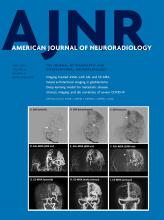Research ArticleAdult Brain
Open Access
Machine Learning–Based Prediction of Small Intracranial Aneurysm Rupture Status Using CTA-Derived Hemodynamics: A Multicenter Study
Z. Shi, G.Z. Chen, L. Mao, X.L. Li, C.S. Zhou, S. Xia, Y.X. Zhang, B. Zhang, B. Hu, G.M. Lu and L.J. Zhang
American Journal of Neuroradiology April 2021, 42 (4) 648-654; DOI: https://doi.org/10.3174/ajnr.A7034
Z. Shi
aFrom the Department of Diagnostic Radiology (Z.S., C.S.Z., B.H., G.M.L., L.J.Z.), Jinling Hospital, Medical School of Nanjing University, Nanjing, Jiangsu, China
G.Z. Chen
bDepartment of Medical Imaging (G.Z.C.), Nanjing First Hospital, Nanjing, Jiangsu, China
L. Mao
cDeepwise AI Lab (L.M., X.L.L.), Beijing, China
X.L. Li
cDeepwise AI Lab (L.M., X.L.L.), Beijing, China
C.S. Zhou
aFrom the Department of Diagnostic Radiology (Z.S., C.S.Z., B.H., G.M.L., L.J.Z.), Jinling Hospital, Medical School of Nanjing University, Nanjing, Jiangsu, China
S. Xia
dDepartment of Radiology (S.X.), Tianjin First Central Hospital, Tianjin, China
Y.X. Zhang
eLaboratory of Image Science and Technology (Y.X.Z.), School of Computer Science and Engineering, Southeast University, Nanjing, China
B. Zhang
fDepartment of Radiology (B.Z.), Taizhou People’s Hospital, Taizhou, Jiangsu, China
B. Hu
aFrom the Department of Diagnostic Radiology (Z.S., C.S.Z., B.H., G.M.L., L.J.Z.), Jinling Hospital, Medical School of Nanjing University, Nanjing, Jiangsu, China
G.M. Lu
aFrom the Department of Diagnostic Radiology (Z.S., C.S.Z., B.H., G.M.L., L.J.Z.), Jinling Hospital, Medical School of Nanjing University, Nanjing, Jiangsu, China
L.J. Zhang
aFrom the Department of Diagnostic Radiology (Z.S., C.S.Z., B.H., G.M.L., L.J.Z.), Jinling Hospital, Medical School of Nanjing University, Nanjing, Jiangsu, China

References
- 1.↵
- Vlak MH,
- Algra A,
- Brandenburg R, et al
- 2.↵
- Murayama Y,
- Takao H,
- Ishibashi T, et al
- 3.↵
- 4.↵
- 5.↵
- 6.↵
- 7.↵
- Thompson BG,
- Brown RD Jr.,
- Amin-Hanjani S, et al
- 8.↵
- 9.↵
- UCAS Japan Investigators,
- Morita A,
- Kirino T, et al
- 10.↵
- 11.↵
- Meng H,
- Tutino VM,
- Xiang J, et al
- 12.↵
- 13.↵
- Güresir E,
- Vatter H,
- Schuss P, et al
- 14.↵
- Varble N,
- Tutino VM,
- Yu J, et al
- 15.↵
- Krittanawong C,
- Zhang H,
- Wang Z, et al
- 16.↵
- 17.↵
- 18.↵
- Zack CJ,
- Senecal C,
- Kinar Y, et al
- 19.↵
- Tanioka S,
- Ishida F,
- Yamamoto A, et al
- 20.↵
- 21.↵
- 22.↵
- 23.↵
- Cebral JR,
- Mut F,
- Weir J, et al
- 24.↵
- Detmer FJ,
- Chung BJ,
- Mut F, et al
- 25.↵
- Hanley JA,
- McNeil BJ
- 26.↵
- Pedregosa F,
- Varoquaux G,
- Gramfort A, et al
- 27.↵
- 28.↵
- 29.↵
- Chiu JJ,
- Chien S
- 30.↵
- Chatziprodromou I,
- Tricoli A,
- Poulikakos D, et al
- 31.↵
- Pereira VM,
- Brina O,
- Bijlenga P, et al
- 32.↵
- Lauric A,
- Hippelheuser J,
- Cohen AD, et al
- 33.↵
- Miura Y,
- Ishida F,
- Umeda Y, et al
- 34.↵
- 35.↵
- Chalouhi N,
- Hoh BL,
- Hasan D
- 36.↵
- 37.↵
- Liang L,
- Steinman DA,
- Brina O, et al
In this issue
American Journal of Neuroradiology
Vol. 42, Issue 4
1 Apr 2021
Advertisement
Z. Shi, G.Z. Chen, L. Mao, X.L. Li, C.S. Zhou, S. Xia, Y.X. Zhang, B. Zhang, B. Hu, G.M. Lu, L.J. Zhang
Machine Learning–Based Prediction of Small Intracranial Aneurysm Rupture Status Using CTA-Derived Hemodynamics: A Multicenter Study
American Journal of Neuroradiology Apr 2021, 42 (4) 648-654; DOI: 10.3174/ajnr.A7034
0 Responses
Machine Learning–Based Prediction of Small Intracranial Aneurysm Rupture Status Using CTA-Derived Hemodynamics: A Multicenter Study
Z. Shi, G.Z. Chen, L. Mao, X.L. Li, C.S. Zhou, S. Xia, Y.X. Zhang, B. Zhang, B. Hu, G.M. Lu, L.J. Zhang
American Journal of Neuroradiology Apr 2021, 42 (4) 648-654; DOI: 10.3174/ajnr.A7034
Jump to section
Related Articles
Cited By...
- No citing articles found.
This article has been cited by the following articles in journals that are participating in Crossref Cited-by Linking.
- Mohammad Amin Habibi, Amirata Fakhfouri, Mohammad Sina Mirjani, Alireza Razavi, Ali Mortezaei, Yasna Soleimani, Sohrab Lotfi, Shayan Arabi, Ladan Heidaresfahani, Sara Sadeghi, Poriya Minaee, SeyedMohammad Eazi, Farhang Rashidi, Milad Shafizadeh, Shahram MajidiNeurosurgical Review 2024 47 1
- Ke Wu, Dongdong Gu, Peihong Qi, Xiaohuan Cao, Dijia Wu, Lei Chen, Guoxiang Qu, Jiayu Wang, Xianpan Pan, Xuechun Wang, Yuntian Chen, Lizhou Chen, Zhong Xue, Jinhao LyuComputerized Medical Imaging and Graphics 2022 102
- Dongqin Zhu, Yongchun Chen, Kuikui Zheng, Chao Chen, Qiong Li, Jiafeng Zhou, Xiufen Jia, Nengzhi Xia, Hao Wang, Boli Lin, Yifei Ni, Peipei Pang, Yunjun YangFrontiers in Neuroscience 2021 15
- Xi Chen, Yu Lei, Jiabin Su, Heng Yang, Wei Ni, Jinhua Yu, Yuxiang Gu, Ying MaoCurrent Neuropharmacology 2022 20 7
- WeiGen Xiong, TingTing Chen, Jun Li, Lan Xiang, Cheng Zhang, Liang Xiang, YingBin Li, Dong Chu, YueZhang Wu, Qiong Jie, RunZe Qiu, ZeYue Xu, JianJun Zou, HongWei Fan, ZhiHong ZhaoNeurological Sciences 2022 43 11
- Stavropoula I. Tjoumakaris, Ricardo Hanel, J Mocco, M. Ali-Aziz Sultan, Michael Froehler, Barry B. Lieber, Alexander Coon, Satoshi Tateshima, David J. Altschul, Sandra Narayanan, Kareem El Naamani, Phil Taussky, Brian L. Hoh, Philip Meyers, Matthew J. Gounis, David S. Liebeskind, Victor Volovici, Gabor Toth, Adam Arthur, Ajay K. WakhlooStroke 2024 55 5
- Renugadevi Ammapalayam Sinnaswamy, Natesan Palanisamy, Kavitha Subramaniam, Suresh Muthusamy, Ravita Lamba, Sreejith SekaranWireless Personal Communications 2023 131 3
- Rong Chen, Xiao Mo, Zhenpeng Chen, Pujie Feng, Haiyun LiFrontiers in Neurology 2022 13
- Michael A. Silva, Stephanie Chen, Robert M. StarkeSurgical Neurology International 2022 13
- Yuan Xie, Shuyu Liu, Hen Lin, Min Wu, Feng Shi, Feng Pan, Lichi Zhang, Bin SongFrontiers in Neurology 2023 14
More in this TOC Section
Adult Brain
Similar Articles
Advertisement











